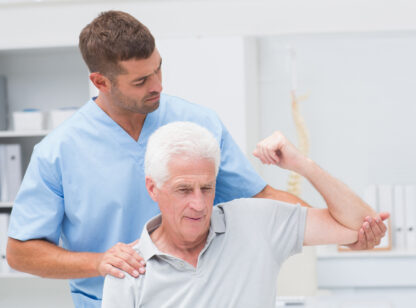In the world of chiropractic health care, spinal decompression is promoted as the latest technology to relieve back pain caused by compressed or degenerative discs. Although some within the medical community, including the Mayo Clinic, are using the treatment for conditions such as herniated and bulging discs, spinal stenosis, and sciatica, most doctors are awaiting results of blind placebo studies that scientifically prove the treatment is effective.
The therapy is relatively new… non-surgical spinal decompression was pioneered by Dr. Allan Dyer, PhD, MD who introduced the first spinal decompression table in 1991.1 Decompression is achieved through the use of a mechanical traction device applied through an on-board computer that controls the force and angle of disc distraction. The program enables the table to apply a very slight and slow traction force to the discs of the spinal column reducing intradiscal pressure and increasing blood flow to those compressed areas. Many other doctors, scientists, and corporations have developed spinal decompression tables, each with features believed to mimic or enhance the effectiveness of the original concept.2
Enthusiasm for this therapy stems from the ineffectiveness of traditional non-surgical therapies in relieving pain, and the belief that spinal decompression offers a less invasive option to surgery.
But does it work? The National Institutes of Health website reports that there have been two pilot studies which show that non-surgical spinal decompression treatment has a beneficial effect on lower back pain, enhancing the structure of the spine by increasing disc height. One study authored by Dr. John Leslie of the Mayo Clinic and others, found that clinical use of a spinal decompression system led to an 88.9 percent reduction in pain scores over six weeks, as well as a drop in consumption of pain medications and improvement in quality of life.3
In the other study, CT scans of the lumbar spine in patients before and after spinal decompression treatment showed possible beneficial anatomical changes. Dr. Christian Apfel, lead author of this study and associate professor of anesthesiology and perioperative care at the University of California at San Francisco, says, “A significant reduction in chronic lower back pain after non-invasive spinal decompression correlated with an increase in disc height.”3 It is noted that these studies were not conducted using scientific standards. Many agree that a similar controlled, randomized trial is required to prove that increased disc height leads to pain amelioration.
Yet for many who have suffered with back pain for long periods of time, and have tried traditional therapies including pain medications, physical therapy and epidurals to no avail, spinal decompression is an effective option. “Most of my spinal decompression patients arrive with MRI in hand,” says Dr. Larry Le Roy of Le Roy Chiropractic in La Quinta. “They have tried the route of pain meds and epidurals and been told that surgery is the best option.”
75% of the patients he sees are golfers and they want to keep golfing. “I’m an athlete too, and I get it. Life is no fun when you can’t enjoy your sports and hobbies, so our goal is to alleviate pain and get them back to what they love doing.”
Dr. Le Roy explains how decompression creates a negative pressure and pulls blood into the affected area and helps bring the discs back to life. “Disc degeneration means the disc is dying. It is not getting the nutrients it needs. Is (spinal decompression) going to give you the disc of a 20 year old? No. But if we can get some life back into those discs, we can take the pressure off the nerves and give the patient relief from pain.”
Karen Adamik of Indio is a believer. What started in 2009 as a slight pain in her knee expanded throughout her body and left her unable to walk. She was diagnosed with herniated and degenerated disks in her lower back. Over 18 months, she pursued relief through physical therapy, pain medications and steroid injections, but nothing provided relief beyond two months. She was told surgery was her next option and was looking forward to long-term relief. Her surgeon told Karen the procedure probably still wouldn’t relieve the pain and that he wouldn’t recommend it. Taken back, she sought a second option from a neurosurgeon who agreed that surgery would probably not alleviate the pain long-term.
A friend mentioned spinal decompression and Adamik thought ‘what have I got to lose.’ She started treatment in January of 2011 and believes it saved her life. She now walks 3 miles a day and is back to doing the things she enjoys. “I stopped living as pain management took over my life.” She adds that, for her condition, spinal decompression was a good choice. She began with 24 treatments going 3 times a week and currently is on a once a month maintenance program. Her spinal decompression treatments, which she adds are painless, are coupled with chiropractic adjustments. With Dr. Le Roy’s encouragement, she increased her exercise as her pain eased and has lost 55 pounds.
“As part of a comprehensive treatment plan, we recommend physical therapy or rehab to strengthen core muscles, and chiropractic adjustments specific to a patient’s condition,” adds Le Roy.
He states that contraindications to spinal decompression therapy include (but are not limited to) severe osteoporosis, pregnancy, severe obesity, and post-surgery that includes metal screws or cages.
If spinal decompression sounds like a good option, what are the factors to consider?
“Ensure that the your doctor is trained on the modality from experts, not only the manufacturer,” says Le Roy, as the programmed weight, angles and treatment time are factors determined by the doctor based on one’s specific MRI and condition. “The treatment does not hurt and if it does, there is something wrong with the settings or position.” In addition, a thorough examination should include an MRI or other acceptable imaging.
Although science has yet to prove the validity of spinal decompression, many are successfully using the therapy to relieve chronic pain. “I now understand that there is no quick fix for pain free living, concludes Adamik, “but as long as I continue my maintenance program and healthier lifestyle, I live pain free – and feel like myself again!”
References: 1) http://www.vaxd.net/about.htm; 2) http://en.wikipedia.org/wiki/Spinal_decompression; 3) National Institutes of Health website http://www.ncbi.nlm.nih.gov/pmc/articles/PMC1887522/











































Comments (1)
Overall, there are lots of advantages to pills over
other forms of colon cleanse pills (http://www.gogreenwebdirectory.com/) cleanses.